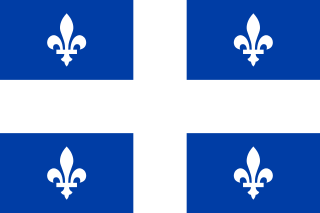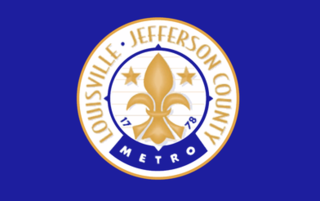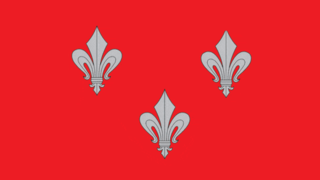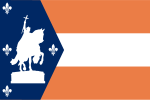
The national flag of France is a tricolour featuring three vertical bands coloured blue, white, and red. The design was adopted after the French Revolution, whose revolutionaries were influenced by the horizontally striped red-white-blue flag of the Netherlands. While not the first tricolour, it became one of the most influential flags in history. The tricolour scheme was later adopted by many other nations in Europe and elsewhere, and, according to the Encyclopædia Britannica has historically stood "in symbolic opposition to the autocratic and clericalist royal standards of the past".

The fleur-de-lis, also spelled fleur-de-lys, is a common heraldic charge in the shape of a lily. Most notably, the fleur-de-lis is depicted on the traditional coat of arms of France that was used from the High Middle Ages until the French Revolution in 1792, and then again in brief periods in the 19th century. This design still represents France and the House of Bourbon in the form of marshalling in the arms of Spain, Quebec, and Canada — for example.

The National Flag of Canada, often referred to simply as the Canadian flag, consists of a red field with a white square at its centre in the ratio of 1∶2∶1, in which is featured one stylized, red, 11-pointed maple leaf charged in the centre. It is the first flag to have been adopted by both houses of Parliament and officially proclaimed by the Canadian monarch as the country's official national flag. The flag has become the predominant and most recognizable national symbol of Canada.

The flag of Quebec, called the Fleurdelisé in French, represents the Canadian province of Quebec. It consists of a white cross on a blue background, with four white fleurs-de-lis.
In heraldry, variations of the field are any of a number of ways that a field may be covered with a pattern, rather than a flat tincture or a simple division of the field.

The coat of arms of Yukon is the heraldic symbol representing the Canadian territory of Yukon. The arms was commissioned by the federal Department of Indian Affairs and Northern Development and designed by well-known heraldry expert Alan Beddoe in the early 1950s. It was officially approved by Queen Elizabeth II in 1956.

The city of Louisville, Kentucky used two flags: the original design paid homage to Louis XVI of France and the thirteen states present when the city was founded, and the current design was adopted in 2003 when the city merged with Jefferson County, Kentucky.

The city flag of Los Angeles consists of a background of three notched stripes of green, gold and red. The flag was designed by Roy E. Silent and E.S. Jones in 1931 for the Los Angeles sesquicentennial from 1781.
The people and province of Quebec have created and established several symbols throughout Quebec's history to represent the collective identity of its residents. Many of Quebec's symbols are related to its history, to catholicism, to Quebec's winters and/or the fauna and flora of Quebec. The motif most commonly seen in Quebec's various symbols is the fleur de lys, which is associated with the French language and New France.

The flag of Baton Rouge contains a red field with a small shield and cursive text reading "Baton Rouge". The current flag was adopted in 1995 by the city council, replacing an older flag that had been in use since 1968.

An unofficial flag of Saint Barthélemy consisting of the coat of arms of Saint Barthélemy centered on a white field is used on the island. Officially, only the flag of France, of which Saint Barthélemy is a self-governing overseas collectivity, is flown in the territory.

The flag of New Orleans contains a large white field that contains three gold fleurs-de-lis and is bordered on the top by a red stripe and from below by a blue stripe. The presence of the fleur-de-lis, a stylized depiction of a flower and a traditional French symbol demonstrates the city's French heritage and strong ties to France, while the presence of the design being a Spanish fess demonstrates the city's Spanish heritage and strong ties to Spain.

The Bedfordshire flag is the flag of the English county of Bedfordshire. It is based on the banner of the arms of the former Bedfordshire County Council, which was granted the arms in 1951 by the College of Arms. This design was adopted as the flag of the historic county in September 2014, with the support of the High Sheriff of the county.

The flag of Fort Wayne, Indiana was adopted as the city's official flag by City Council on June 26, 1934. The pall design includes two diagonal white stripes converging in the circular center to form a horizontal white stripe. Red silhouettes of a Miami Native American head, a French fleur-de-lis, and a British lion grace a navy blue field. A red blockhouse is located at the center of the converging stripes, with the settlement's founding date and city name.

The city flag of Knoxville, Tennessee was officially adopted by municipal ordinance on October 16, 1896. It is the third oldest official city flag in the United States and the oldest flag of any state or city governmental entity in Tennessee.

The flag and coat of arms of Jurbarkas represents Jurbarkas, Lithuania with a red banner charged with three silver-white fleurs-de-lis in the center, two over one. An example of heraldic flag design, the flag employs the city's coat of arms, making it a banner of arms. The design of the arms of Jurbarkas is believed to originate from the arms of the Sapieha house, a noble family from the Grand Duchy of Lithuania which was responsible for Jurbarkas receiving city rights and the coat of arms in 1611.

The current city flag of Columbus, Ohio is a yellow-white-red vertical triband with the city seal on a blue field. Officially, the flag was adopted in 1929, although it is unknown if the flag was ever flown when it was first adopted.

The flag of South Bend, Indiana was adopted by the city council during the mayorship of Pete Buttigieg on April 25, 2016. It is a field of white and yellow separated by a two blue curved lines with a white line between them and a red six-pointed star in the upper left corner.
 One of the flags used during St. Louis World's Fair (1904)
One of the flags used during St. Louis World's Fair (1904)

















